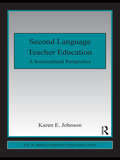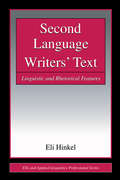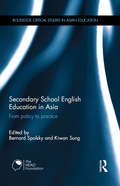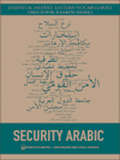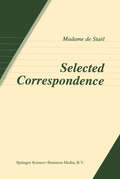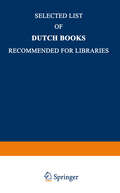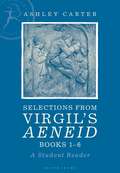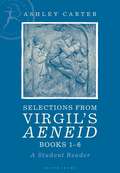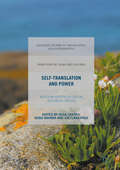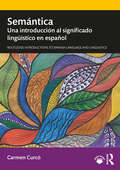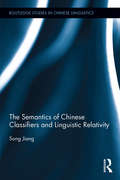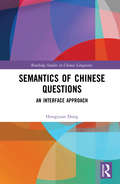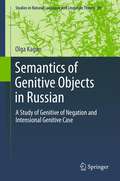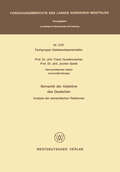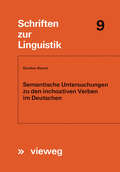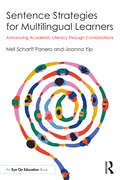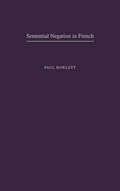- Table View
- List View
Second Language Teacher Education: A Sociocultural Perspective (ESL & Applied Linguistics Professional Series)
by Karen E. Johnson'… A beautifully written, articulate and compelling argument for a sociocultural perspective on second language teacher education . . . Essential reading for all who wish to understand this perspective.' – David Nunan, University of Hong Kong '…Significant and timely. Johnson is masterful at writing in an engaging, transparent prose about complex concepts. It’s a rare scholar who can write prose like this. Throughout my reading I wanted to engage in dialogue with her – this is a sure sign of a great book." – Diane Tedick, University of Minnesota, USA This book presents a comprehensive overview of the epistemological underpinnings of a sociocultural perspective on human learning and addresses in detail what this perspective has to offer the field of second language teacher education. Captured through five changing points of view, it argues that a sociocultural perspective on human learning changes the way we think about how teachers learn to teach, how teachers think about language, how teachers teach second languages, the broader social, cultural, and historical macro-structures that are ever present and ever changing in the second language teaching profession, and what constitutes second language teacher professional development. Overall, it clearly and accessibly makes the case that a sociocultural perspective on human learning reorients how the field understands and supports the professional development of second language teachers.
Second Language Teacher Education: A Sociocultural Perspective (ESL & Applied Linguistics Professional Series)
by Karen E. Johnson'… A beautifully written, articulate and compelling argument for a sociocultural perspective on second language teacher education . . . Essential reading for all who wish to understand this perspective.' – David Nunan, University of Hong Kong '…Significant and timely. Johnson is masterful at writing in an engaging, transparent prose about complex concepts. It’s a rare scholar who can write prose like this. Throughout my reading I wanted to engage in dialogue with her – this is a sure sign of a great book." – Diane Tedick, University of Minnesota, USA This book presents a comprehensive overview of the epistemological underpinnings of a sociocultural perspective on human learning and addresses in detail what this perspective has to offer the field of second language teacher education. Captured through five changing points of view, it argues that a sociocultural perspective on human learning changes the way we think about how teachers learn to teach, how teachers think about language, how teachers teach second languages, the broader social, cultural, and historical macro-structures that are ever present and ever changing in the second language teaching profession, and what constitutes second language teacher professional development. Overall, it clearly and accessibly makes the case that a sociocultural perspective on human learning reorients how the field understands and supports the professional development of second language teachers.
Second Language Writers' Text: Linguistic and Rhetorical Features (ESL & Applied Linguistics Professional Series)
by Eli HinkelThis comprehensive and detailed analysis of second language writers' text identifies explicitly and quantifiably where their text differs from that of native speakers of English. The book is based on the results of a large-scale study of university-level native-speaker and non-native-speaker essays written in response to six prompts. Specifically, the research investigates the frequencies of uses of 68 linguistic (syntactic and lexical) and rhetorical features in essays written by advanced non-native speakers compared with those in the essays of native speakers enrolled in first-year composition courses. The selection of features for inclusion in this analysis is based on their textual functions and meanings, as identified in earlier research on English language grammar and lexis. Such analysis is valuable because it can inform the teaching of grammar and lexis, as well as discourse, and serve as a basis for second language curriculum and course design; and provide valuable insight for second language pedagogical applications of the study's findings.
Second Language Writers' Text: Linguistic and Rhetorical Features (ESL & Applied Linguistics Professional Series)
by Eli HinkelThis comprehensive and detailed analysis of second language writers' text identifies explicitly and quantifiably where their text differs from that of native speakers of English. The book is based on the results of a large-scale study of university-level native-speaker and non-native-speaker essays written in response to six prompts. Specifically, the research investigates the frequencies of uses of 68 linguistic (syntactic and lexical) and rhetorical features in essays written by advanced non-native speakers compared with those in the essays of native speakers enrolled in first-year composition courses. The selection of features for inclusion in this analysis is based on their textual functions and meanings, as identified in earlier research on English language grammar and lexis. Such analysis is valuable because it can inform the teaching of grammar and lexis, as well as discourse, and serve as a basis for second language curriculum and course design; and provide valuable insight for second language pedagogical applications of the study's findings.
Secondary School English Education in Asia: From policy to practice (Routledge Critical Studies in Asian Education)
by Bernard Spolsky Kiwan SungContinuing on from the previously published Primary School English-Language Education in Asia: From Policy to Practice (Moon & Spolsky, 2012), this book compiles the proceedings which took place at the 2011 annual conference of AsiaTEFL which took place in Seoul, Korea. It surveys the current status, practices, challenges, and future directions of Secondary English education in 11 diverse countries - in Israel, Japan, Korea, Singapore, Bangladesh, India, Indonesia, Malaysia, Pakistan, Vietnam and China. Given the importance of secondary English education as the central feature for continuing development of target language and culture in English language teaching in Asia, each contributed chapter includes key policies, theories, and practices related to the development and implementation of country-specific curricular and instructional programs in secondary English educational contexts in these countries. Secondary School English Education in Asia: From Policy to Practice critically analyses both sides of the English language debate – from advantages to complications – in its chapters including: Educating for the 21st Century: The Singapore Experience Miles to Go …: Secondary Level English Language Education in India English Language Education Innovation for the Vietnamese Secondary School: The Project 2020 Exploring the Value of ELT as a Secondary School Subject in China: A Multi-goal Model for English Curriculum Secondary School English Education in Asia will appeal to English Language Teaching (ELT) researchers, teacher educators, trainee teachers and teachers, primarily those teaching in Asia.
Secondary School English Education in Asia: From policy to practice (Routledge Critical Studies in Asian Education)
by Bernard Spolsky Kiwan SungContinuing on from the previously published Primary School English-Language Education in Asia: From Policy to Practice (Moon & Spolsky, 2012), this book compiles the proceedings which took place at the 2011 annual conference of AsiaTEFL which took place in Seoul, Korea. It surveys the current status, practices, challenges, and future directions of Secondary English education in 11 diverse countries - in Israel, Japan, Korea, Singapore, Bangladesh, India, Indonesia, Malaysia, Pakistan, Vietnam and China. Given the importance of secondary English education as the central feature for continuing development of target language and culture in English language teaching in Asia, each contributed chapter includes key policies, theories, and practices related to the development and implementation of country-specific curricular and instructional programs in secondary English educational contexts in these countries. Secondary School English Education in Asia: From Policy to Practice critically analyses both sides of the English language debate – from advantages to complications – in its chapters including: Educating for the 21st Century: The Singapore Experience Miles to Go …: Secondary Level English Language Education in India English Language Education Innovation for the Vietnamese Secondary School: The Project 2020 Exploring the Value of ELT as a Secondary School Subject in China: A Multi-goal Model for English Curriculum Secondary School English Education in Asia will appeal to English Language Teaching (ELT) researchers, teacher educators, trainee teachers and teachers, primarily those teaching in Asia.
Security Arabic: Security Arabic
by Mark EvansWhat is the Arabic term for ‘sleeper cell’? How would you say 'hijacker'? Can you recognise the phrase 'operational planning'? Or 'money-laundering investigations'? This short, accessible vocabulary gives you ready-made lists of key terms in security Arabic for translating both from and into Arabic. It is divided into 13 key areas:* General* Global Security* Organisations* Energy Security* Weapons of Mass Destruction* Defence and Military* Law Enforcement* Counter Terrorism* Human Intelligence* Communications Technology* Information Technology* Information Security* Intelligence Analysis
Selected Correspondence
by Anne Louise de StaëlIn her letters Mme de Staël provides a panoramic historical outlook of the European literary, cultural and political scene between 1789 and 1817, i.e. the Revolution, the Napoleonic era and the Restoration. This edition, as its French original, includes rare contemporary illustrations never published before in this connection. For this book there is no specific level of readership.
Selections from Virgil's Aeneid Books 1-6: A Student Reader
by Ashley CarterThis reader of Virgil's text features passages from the first half of the Aeneid and is designed to help students understand and appreciate Virgil's poem, as well as improve their Latin reading skills. Each Latin passage is accompanied by running vocabulary, on-page commentary notes and targeted questions. The book can be used as a source of one-off unseen passages or as a reader for students working through individual books or the whole poem. The commentary notes explain references to characters, places and events, provide linguistic and grammatical help on more challenging Latin phrases, and point out stylistic features. The questions test students' comprehension of the characters and storyline, and give them practice in handling literary terms. The passages are linked by summaries of the continuing plot, so students can grasp the progression of the poem as a whole. An in-depth introduction sets the story of the Aeneid in its mythological, literary and historical contexts; a glossary of literary devices and sections on style and metre are included. At the end of the book is a complete alphabetical vocabulary list.
Selections from Virgil's Aeneid Books 1-6: A Student Reader
by Ashley CarterThis reader of Virgil's text features passages from the first half of the Aeneid and is designed to help students understand and appreciate Virgil's poem, as well as improve their Latin reading skills. Each Latin passage is accompanied by running vocabulary, on-page commentary notes and targeted questions. The book can be used as a source of one-off unseen passages or as a reader for students working through individual books or the whole poem. The commentary notes explain references to characters, places and events, provide linguistic and grammatical help on more challenging Latin phrases, and point out stylistic features. The questions test students' comprehension of the characters and storyline, and give them practice in handling literary terms. The passages are linked by summaries of the continuing plot, so students can grasp the progression of the poem as a whole. An in-depth introduction sets the story of the Aeneid in its mythological, literary and historical contexts; a glossary of literary devices and sections on style and metre are included. At the end of the book is a complete alphabetical vocabulary list.
Self-Translation and Power: Negotiating Identities in European Multilingual Contexts (Palgrave Studies in Translating and Interpreting)
by Olga Castro Sergi Mainer Svetlana PageThis book investigates the political, social, cultural and economic implications of self-translation in multilingual spaces in Europe. Engaging with the ‘power turn’ in translation studies contexts, it offers innovative perspectives on the role of self-translators as cultural and ideological mediators. The authors explore the unequal power relations and centre-periphery dichotomies of Europe’s minorised languages, literatures and cultures. They recognise that the self-translator’s double affiliation as author and translator places them in a privileged position to challenge power, to negotiate the experiences of the subaltern and colonised, and to scrutinise conflicting minorised vs. hegemonic cultural identities. Three main themes are explored in relation to self-translation: hegemony and resistance; self-minorisation and self-censorship; and collaboration, hybridisation and invisibility. This edited collection will appeal to scholars and students working on translation, transnational and postcolonial studies, and multilingual and multicultural identities.
Semántica: Una introducción al significado lingüístico en español
by Carmen CurcóSemántica: Una introducción al significado lingüístico en español es una introducción integral al estudio de la semántica con un enfoque especial en la lengua española. Sin asumir conocimientos lingüísticos previos, el libro conduce al lector por los principales temas del estudio del significado, logrando un equilibrio entre la teoría y la práctica. Los temas nocionales y las discusiones conceptuales se entrelazan con el desarrollo de herramientas analíticas. Las explicaciones se apoyan en abundantes ejemplos que ilustran los puntos tratados. Cada capítulo proporciona ejercicios y sugerencias para lecturas e investigaciones adicionales con el fin de guiar a los estudiantes de español en las complejidades de la semántica léxica y composicional. Escrito íntegramente en español en un estilo claro y atractivo, el libro es ideal para estudiantes avanzados de pregrado y posgrado de español y lingüística hispánica. Semántica: Una introducción al significado lingüístico en español is a comprehensive introduction to the study of semantics with a special focus on Spanish. Without assuming prior linguistic knowledge, the book leads the reader through the main topics in the study of meaning, striking a balance between theory and practice. In a clear and engaging style, notional issues and conceptual discussions are intertwined with the development of analytical tools. Explanations are supported by plentiful examples to reinforce each new point. Exercises and suggestions for further reading and research are provided throughout to guide students of Spanish seamlessly into the complexities of lexical and compositional semantics. Written entirely in Spanish, the book is ideal for advanced undergraduate and graduate students of Spanish and Spanish linguistics.
Semántica: Una introducción al significado lingüístico en español
by Carmen CurcóSemántica: Una introducción al significado lingüístico en español es una introducción integral al estudio de la semántica con un enfoque especial en la lengua española. Sin asumir conocimientos lingüísticos previos, el libro conduce al lector por los principales temas del estudio del significado, logrando un equilibrio entre la teoría y la práctica. Los temas nocionales y las discusiones conceptuales se entrelazan con el desarrollo de herramientas analíticas. Las explicaciones se apoyan en abundantes ejemplos que ilustran los puntos tratados. Cada capítulo proporciona ejercicios y sugerencias para lecturas e investigaciones adicionales con el fin de guiar a los estudiantes de español en las complejidades de la semántica léxica y composicional. Escrito íntegramente en español en un estilo claro y atractivo, el libro es ideal para estudiantes avanzados de pregrado y posgrado de español y lingüística hispánica. Semántica: Una introducción al significado lingüístico en español is a comprehensive introduction to the study of semantics with a special focus on Spanish. Without assuming prior linguistic knowledge, the book leads the reader through the main topics in the study of meaning, striking a balance between theory and practice. In a clear and engaging style, notional issues and conceptual discussions are intertwined with the development of analytical tools. Explanations are supported by plentiful examples to reinforce each new point. Exercises and suggestions for further reading and research are provided throughout to guide students of Spanish seamlessly into the complexities of lexical and compositional semantics. Written entirely in Spanish, the book is ideal for advanced undergraduate and graduate students of Spanish and Spanish linguistics.
The Semantics of Chinese Classifiers and Linguistic Relativity (Routledge Studies in Chinese Linguistics)
by Song JiangThe Semantics of Chinese Classifiers and Linguistic Relativity focuses on the semantic structure of Chinese classifiers under the cognitive linguistics framework, and the implications thereof on linguistic relativity and language acquisition. It examines the semantic correlation between a given classifier and its associated nouns. Nouns in Chinese, which are assigned specific classifiers according to their selected characteristics, reflect the process of human categorization. The concrete categories formed by the relationship between nouns and classifiers may serve to explain the conceptual structure of the Chinese language and certain underlying aspects of culture and human cognition. Song Jiang is Assistant Professor of Chinese for the Department of East Asian Languages and Literatures at university of Hawai‘i at Mānoa.
The Semantics of Chinese Classifiers and Linguistic Relativity (Routledge Studies in Chinese Linguistics)
by Song JiangThe Semantics of Chinese Classifiers and Linguistic Relativity focuses on the semantic structure of Chinese classifiers under the cognitive linguistics framework, and the implications thereof on linguistic relativity and language acquisition. It examines the semantic correlation between a given classifier and its associated nouns. Nouns in Chinese, which are assigned specific classifiers according to their selected characteristics, reflect the process of human categorization. The concrete categories formed by the relationship between nouns and classifiers may serve to explain the conceptual structure of the Chinese language and certain underlying aspects of culture and human cognition. Song Jiang is Assistant Professor of Chinese for the Department of East Asian Languages and Literatures at university of Hawai‘i at Mānoa.
Semantics of Chinese Questions: An Interface Approach (Routledge Studies in Chinese Linguistics)
by Hongyuan DongSemantics of Chinese Questions is the first major study of Chinese questions, especially wh-questions, within the framework of Alternative Semantics. It takes an interface approach to study the syntax, semantics, and phonology of questions and proposes a phonological scope-marking strategy in Chinese questions, based upon experimental data. It also incorporates historical linguistic data regarding the grammaticalization of sentence-final particles such as –ne and –ma to study the formal diachronic semantics of questions. Primarily suitable for scholars in the field of Chinese linguistics, this book makes new theoretical contributions to the study of questions.
Semantics of Chinese Questions: An Interface Approach (Routledge Studies in Chinese Linguistics)
by Hongyuan DongSemantics of Chinese Questions is the first major study of Chinese questions, especially wh-questions, within the framework of Alternative Semantics. It takes an interface approach to study the syntax, semantics, and phonology of questions and proposes a phonological scope-marking strategy in Chinese questions, based upon experimental data. It also incorporates historical linguistic data regarding the grammaticalization of sentence-final particles such as –ne and –ma to study the formal diachronic semantics of questions. Primarily suitable for scholars in the field of Chinese linguistics, this book makes new theoretical contributions to the study of questions.
Semantics of Genitive Objects in Russian: A Study of Genitive of Negation and Intensional Genitive Case (Studies in Natural Language and Linguistic Theory #89)
by Olga KaganThe genitive/accusative opposition in Slavic languages is a decades-old linguistic conundrum. Shedding new light on this perplexing object-case alternation in Russian, this volume analyzes two variants of genitive objects that alternate with accusative complements—the genitive of negation and the intensional genitive. The author contends that these variants are manifestations of the same phenomenon, and thus require an integrated analysis. Further, that the choice of case is sensitive to factors that fuse semantics and pragmatics, and that the genitive case is assigned to objects denoting properties at the same time as they lack commitment to existence. Kagan’s subtle analysis accounts for the complex relations between case-marking and other properties, such as definiteness, specificity, number and aspect. It also reveals a correlation between the genitive case and the subjunctive mood, and relates her overarching subject matter to other instances of differential object-marking.
Semantik der Adjektive des Deutschen: Analyse der semantischen Relationen (Forschungsberichte des Landes Nordrhein-Westfalen #3137)
by Franz HundsnurscherSemantische Untersuchungen zu den inchoativen Verben im Deutschen (Schriften zur Linguistik #9)
by Günther StorchSentence Strategies for Multilingual Learners: Advancing Academic Literacy through Combinations
by Nell Scharff Panero Joanna YipThis book presents Combinations as a set of high-yield instructional strategies for advancing academic literacy for multilingual learners and all students. It discusses the strategies themselves as well as how they work to advance content and language learning simultaneously, across the grades and content areas. The book is particularly beneficial for all teachers working with linguistically and culturally diverse learners to accelerate their language and content learning. Utilizing these strategies will not only greatly improve students’ writing but also supports their critical thinking, content area reading and language comprehension skills. This book argues for utilizing Combinations with Strategic Inquiry, presenting evidence of how each amplifies the impact of the other, and how together they address many of the challenges to learning new and counter-cultural methods and to establishing school and district cultures in support of multilingual learners’ success. This book is a great resource for classroom teachers, literacy coaches and school and district administrators who want to support multilingual learners and all students to thrive.
Sentence Strategies for Multilingual Learners: Advancing Academic Literacy through Combinations
by Nell Scharff Panero Joanna YipThis book presents Combinations as a set of high-yield instructional strategies for advancing academic literacy for multilingual learners and all students. It discusses the strategies themselves as well as how they work to advance content and language learning simultaneously, across the grades and content areas. The book is particularly beneficial for all teachers working with linguistically and culturally diverse learners to accelerate their language and content learning. Utilizing these strategies will not only greatly improve students’ writing but also supports their critical thinking, content area reading and language comprehension skills. This book argues for utilizing Combinations with Strategic Inquiry, presenting evidence of how each amplifies the impact of the other, and how together they address many of the challenges to learning new and counter-cultural methods and to establishing school and district cultures in support of multilingual learners’ success. This book is a great resource for classroom teachers, literacy coaches and school and district administrators who want to support multilingual learners and all students to thrive.
Sentential Negation In French
by Paul RowlettThis is the first full-length study of sentential negation phenomena in French. Paul Rowlett assesses, from a generative perspective, the respective contribution made to the expression of clausal polarity byne,pas, and elements such asjamaisandpersonne. His conclusions have far-reaching implications, leading to the controversial hypothesis that, despite widespread belief, French is not a negative concord language.
Sentential Negation in French
by Paul RowlettThis is the first full-length study of sentential negation phenomena in French. Paul Rowlett assesses, from a generative perspective, the respective contribution made to the expression of clausal polarity by ne, pas, and elements such as jamais and personne. His conclusions have far-reaching implications, leading to the controversial hypothesis that, despite widespread belief, French is not a negative concord language.
